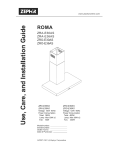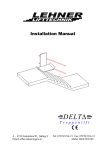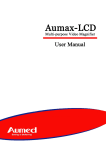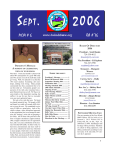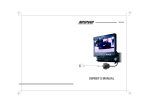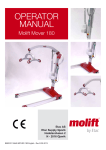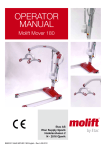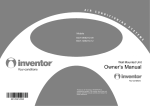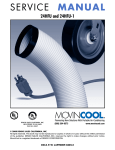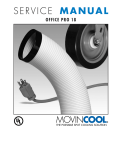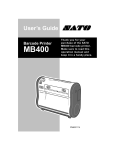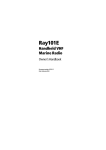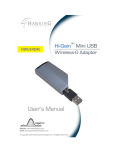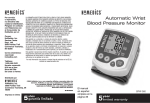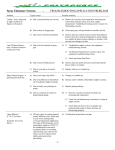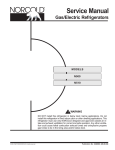Download Service Manual: 2005 Edition
Transcript
GENERAL DESCRIPTION 1. GENERAL DESCRIPTION Generally speaking conventional air conditioners cool the entire enclosed environment. They act as “heat exchangers”, requiring an interior and an exterior unit (condenser) to exhaust exchanged heat to the outdoors. Unlike conventional air conditioners, the SPOT COOL is a cooling system which directs cool air to particular areas or objects. SPOT COOL has the following features; Fig. 1-1 Circuit of Auxiliary Relay 1) Compact Design The innovative design of SPOT COOL has resulted in one compact design, replacing the need for two separate units. 2) Easy Installation With the whole cooling system built into one compact unit, SPOT COOL requires no pipe work for refrigerant and installed easily. In this case, cooling air duct work is required. 3) Energy Conservation SPOT COOL is economical because it cools only the area or objects which need to be cooled, not the entire room. Fig. 1-2 Air Flow of Spot Cool 1 CONSTRUCTION, SPECIFICATIONS and DATA 2. CONSTRUCTION AND SPECIFICATION 2-1. Construction Fig. 2-1 Construction of Hermetric Rotary Type Compressor 2 CONSTRUCTION, SPECIFICATIONS and DATA 1) Basic Construction The SPOT COOL is compact in construction because the condenser and the evaporator are enclosed in one unit. The interior is divided into two sections. The front face is equipped with the evaporator and control box. The rear section contains the condenser and the compressor. 2) Air Flow (See Fig. 1-2) 1. Air flow for the condenser Air is taken through apertures in the rear face and both sides of unit to cool the condenser and discharged through the exhaust air duct at the top of unit. 2. Air flow for the evaporator Air is taken from the front face of unit, cooled via the evaporator, and blown off from the aperture in the unit top. Using a cooling air duct (option, to be installed on the field), blow cool air against an object to be cooled. All air inlets are provided with air filters. 3 CONSTRUCTION, SPECIFICATIONS and DATA 2-2 Specifications Item Model 30HU [Rating Condition] DB 35˚C 95˚F [Features] Power frequency ..................................................... (Hz) Line Voltage .......................................................... (Volt) Power consumption ............................................... (Kw) Current consumption .......................................... (Amp) Power factor ........................................................... (%) Starting current ................................................... (Amp) Power wiring ....................................................... (AWG) [Cooling Unit] Cooling capability ............................................. (Kcal/h) (Btu/h) Cooling system [Blower] Type of fan Air volume ........................................................... (m3/h) (ft3/min) Motor output .......................................................... (Kw) [Compressor] Type Output .................................................................... (Kw) Refrigerant (kg) Packed amount of refrigerant ................................ (lbs) [Safety Device] Overcurrent relays (for compressor, evaporator fanwith motor and condenser fan motor) Compressor overload relay Fan motor protectors (for evaporator and condenser)with High pressure switch Anti-freezing thermostat [Dimensions and Weight] W x D x H .............................................................. (mm) (inch) Weight ..................................................................... (kg) (lbs) [Operating Conditions] Inlet air Fig. 2-1 Construction of Hermetric Rotary Type Compressor 4 WB28.2˚C 83˚F (60%) 60 Three phase 220 4.7 70 88 70 12 (4-core) 9830 39000 Direct expansion Sirroco fan 1800 1060 0.75 Hermetic reciprocating type 2.2 R-22 2.0 4.4)0 with with with 12100 x 650 x 985 43.3 x 25.6 x 38.8 160 353 MAX. 45˚C (113˚F), 50% MIN. 25˚C (77˚F), 50% REFRIGERANT SYSTEM 3. REFRIGERANT SYSTEM The component parts of the refrigerant system include the followings; • Compressor • Evaporator • Condenser • Modulating tank • Capiliary tub • High pressure switch These parts are all connected by copper piping. All the connections have been brazed. Fig. 3-1 Refrigerant system of MODEL 30HU 5 REFRIGERANT SYSTEM 3-1. Compressor The compressor used for this unit is a reciprocating type. It is a hermetic compressor which incorporates a drive motor and a compression mechanism in an enclosed vessel. 3-1-1. Construction The reciprocating type compressor consists of a drive section (motor) and a compressin mechanism as shown in Fig. 3-2. When the rotor shaft of motor rotates, the crank shaft causes the piston to reciprocate in the cylinder and absorb and compress the refrigerant. Main components are the motor, crank case, bearing, crank shaft, cylinder, piston, etc. The motor and compression mechanism are supported by a spring inside the outer shell so that vibration of the compressor does not transmit directly to the outside. The out shell is on the low pressure side, in which gas flows from the evaporator. This gas cools the motor and compression mechanism. Fig. 3-2 Construction of Hermetic Reciprocating Type Compressor 6 REFRIGERANT SYSTEM 3-1-2. Operation 1) Suction When the piston is pushed down, pressure inside the cylinder lowers. When this pressure becomes less than the suction side (low pressure side) pressure, the suction valve at the top of the cylinder is pushed open by the suction side pressure and the refrigerant is sucked into the cylinder. See Fig. 3-3. Fig. 3-3 Suction 2) Compression The refrigerant in the cylinder is pushed up by the piston. As its capacity reduces, its pressure increases gradually. See Fig. 3-4. Fig. 3-4 Compression 3) Discharge When the refrigerant pressure in the cylinder becomes higher than the pressure on the delivery side (hight pressure side) of the compressor, the discharge valve opens to deliver the compressed refrigerant to the discharge side. See Fig. 3-5. Fig. 3-5 Discharge 3-1-3. Lubrication of Compressor In the lubrication system, lubricant from the thrust pad hole enters an eccentric hole in the crank shaft. Here, forced by centrifugal force, the lubricant rises the eccentric hole, enters the spiral groove in the shaft, and rises while simultaneously lubricating the bearing and subsequent areas. Fig. 3-6 Lubrication of Compressor 7 REFRIGERANT SYSTEM 3-2. Condenser The condenser, which serves as a heat exchanger, has thin aluminum projections called spine fins fastened toa copper tube. Heat is exchanged by forcing cooler air across the condenser fins. 3-3. Capillary Tube The following table shows the specifications of the capillary tube. Model Qty Purpose of Use I.D, (mm) Length (mm) 30HU FOR COOLING Ø1.4±0.02 445 4 3-4. Evaporator The evaporator is a heat exchanger using plate-fins and tubes. It is mounted at the front face of the unit, located on the suction side of the blower. 8 REFRIGERANT SYSTEM 3-5. Modulating Tank The modulating tank consists of a copper pipe and tank sections, each being separated from the other. The pipe connects to the evaporator outlet at one end and to the suction pipe of the compressor at the other; the tank connects to the evaporator inlet. The modulating tank is covered with a heat insulator that eliminates thermal effects from ambient temperature. It varies the quantitiy of refrigerant in the refrigerating cycle for optimum operating condition: it stores part of refrigerant under light load and delivers additiona refrigerant to the cycle under heavy load. Fig. 3-7 Modulating Tank 3-6. High Pressure Switch The high pressure switch prevents the condenser and compressor from being damaged by an excessively high pressure in the highpressure end of the refrigerating cycle, i.e., the refrigerant condensing pressure. The switch is normally closed. The diaphragm detects variations in pressure and, as the pressure increases, the snap disk snaps back to pucsh the pin down, causing the internal contacts to open. This generates a signal to open the auxiliary relay. Possible causes of this trouble include: 1) The condenser air filter is seriously contaminated and clogged. Fig. 3-8 2) Defective condense blower. High Pressure Switch 9 REFRIGERANT SYSTEM 3-7. Piping The parts of the cooling system are connected by copper pipe. In the unit, the refrigerant cycle is enclosed. Each connection has been brazed. the circled portion in the figure shows the parts which have been brazed. Fig. 3-9 Refrigerant System Piping for MODEL 30HU 10 ELECTRICAL SYSTEM 4. ELECTRICAL SYSTEM The component parts of the electrical system include the following: • Control box • Overcurrent relays • Control switch • Relays • Fan motor • Lamps etc. • Compressor motor Fig. 4-1 Electrical System for MODEL 30HU 11 ELECTRICAL SYSTEM 4-1. Control Box The interior of the control box is shown in the figure below. Fig. 4-2 Main Control Box Fig. 4-3 12 Sub Control Box ELECTRICAL SYSTEM 4-1-1. Auxiliary Relay When the power is supplied to the unit, this relay is energized across terminals 7 and 8 closed across terminals 5 and 3 and across 6 and 4. These states remain unchanged in all operation modes (FAN or COOL). If one of the errors mentioned below has occurred at the unit, the auxiliary relay is deenergized across terminals 7 and 8, and opened across terminals 5 and 3 and across 6 and 4. This shuts off power to the fan motor relay and compressor motor relay and accordingly brings the unit to a stop. Also, the relay is closed across terminals 6 and 2 to turn on the warning lamp. Fig. 1-1 1. Abnormally large current has flown in the evaporator fan motor. Circuit of Auxiliary Relay Specifications Rated Voltage: AC230 volts Rated current: 10 Amps 2. Abnormally large current has flown in the condenser fan motor. 3. Abnormally large current has flown in the compressor motor. UL Recognized; file E43028 4. Compressor motor temperature has risen abnormally. 5. High pressure has risen abnormally. Fig. 1-1 Circuit of Auxiliary Relay 13 ELECTRICAL SYSTEM 4-1-2. Fan Motor Relay This fan motor relay is closed when the unit is in operation of FAN and COOL mode, and supply power to the fan motor of the evaporator. In the following case, the relay opens to cut off power to the fan motor. When the auxiliary relay is opened by the overcurrent relay OFF, compressor overlaod relay OFF or high pressure switch OFF. Specifications Rated Voltage: AC230 Volts Rated current: 15 amps Fig. 4-6 Circuit of Fan Motor Relay Fig. 4-7 Fan Motor Relay Fig. 4-8 Circuit of Compessor Relay UL listed file No.:E43028 4-1-3. Compressor Relay This compressor relay is closed when the unit is in operation of only COOL mode and supply power to the compressor. In the following case, the relay opens to cut off power to the compressor. When the auxiliary relay is opened by the high pressure switch OFF, overcurrent relay OFF or compressor overload relay OFF. When the evaporator is freezed. (Thermostat OFF) Specifications Rated Voltage: AC230 Volts Rated current: 30 amps UL listed file No.:E43028 14 ELECTRICAL SYSTEM Fig. 4-9 Compressor Relay 4-1-4. Overcurrent Relay For three-phase blower motor and compressor motor, an overcurrent relay is usually used as a safety device. The overcurrent relay prevents motor coil from burning if overcurent has flown into the motor due to abnormal load applied to the blower motor or compressor motor, extraordinary change in supply voltage, or loss of current in one phase. If overcurrent flows into the heating coil would around the bimetal strip, the bimetal strip curls, thereby opening the output contact (across terminals 95 and 96). This output contact shuts off the auxiliary relay circuit and brings the unit to a stop. UL recognized: Fig. 4-10 Internal Construction of Over Current Relay File E78841 Current Setting For compressor motor 16A Fig. 1-1 For evaporator fan motor 2.8A For condenser fan motor 2.0A Circuit of Auxiliary Relay 15 ELECTRICAL SYSTEM 4-2. Control Switch The control switch is employed to start or stop operation. This switch is of 250V, 20A rating rotary type (3-position). The switching positions are OFF-FAN-COOL. Each contact is switched by the cam uniting with the shaft. When the unit is hung from the ceiling, pulling the pull cord allows operation of the control switch. Switch Terminals OFF FAN (5) - (2) Conduct OFF OFF (5) - (1) OFF Conduct (5) - (4) OFF OFF COOL Conduct Conduct Fig. 4-12 Control Switch Fig. 4-13 Control Switch 16 ELECTRICAL SYSTEM 4-3. Fan Motor The fan motors are of three phase, induction type. The following table shows the specifications of the fan motors. When the control switch is set to FAN, the evaporator fan motor rotates. When it is set to COOL, both the evaporator and condenser fan motors rotate. Model/Spec. Output (Watt) Fig. 4-14 Rated Voltage (Volt) For Evaporator 220 750 For Condenser 220 400 Rated Fan Motor 4-4. Compressor Motor The compressor motor is a three phase motor. This motor is built in the compressor. (Refer to 3-1.) Specifications 17 Rated Voltage: 220V Rated Output: 2200W ELECTRICAL SYSTEM 4-5. Thermostat When the evaporator has freezed, the contacts of thermostat open to stop the compressor and the ventilating operation is automatically initiated. When the evaporator is unfreezed, the contacts close to restart the compressor and the cooling operation is initiated. The heat sensing tube of thermostat is mounted at the evaporator outlet tube and is insulated from surrounding air by het insulating material. The setting of thermosate is fixed at -1.5˚C when the contacts are open and at +14.5˚C when the contacts are closed. Fig. 4-15 Thermostat 18 ELECTRICAL SYSTEM 4-6. Wiring Power supplied cord is applied with 12AWG (4-core) wires. Proper connections are indicated at all the wire ends. Faston type No. 250 or 187 terminals are used. Fig. 4-16 Wiring Diagram 19 ELECTRICAL SYSTEM 5. DATA 5-1. Exterior Dimensions Diagram Fig. 5-1 Exterior Demensions of MODEL 30HU 20 ELECTRICAL SYSTEM 5-2. Construction diagram Fig. 5-2 Construction Diagram of MODEL 30HU 21 ELECTRICAL SYSTEM 5-3. Cooling Capability Characteristics 1) Cooling Capability curve Fig. 5-3 Cool Capability Curve 2) Current consumption curve Fig. 5-4 Current Consumption Curve 22 ELECTRICAL SYSTEM 3) Cool air temperature difference curve Fig. 5-5 Cool Air Temperature Difference Curve 4) Static pressure and air volum curve of cool air Fig. 5-6 Static Pressure and Air Volume Curve 23 24 Repair 1. TROUBLESHOOTING .............................................................................. 24 2. INSPECTION OF UNIT ............................................................................ 26 3. DISASSEMBLY ....................................................................................... 27 4. INSPECTION AND REPAIR OF ELECTRICAL SYSTEM .............................. 34 5. INSPECTION AND REPAIR OF REFRIGERANT SYSTEM ........................... 38 6. REASSEMBLY ........................................................................................ 47 25 1. TROUBLESHOOTING Before troubleshooting this system the following inspection should be performed. a) Inspection of power source voltage and phase sequence Check the voltage of the power source. Model 30Hu: Three phase, 220 volt ± 15%, 6-Hz. Check the operation and condition of the fuse or circuit breaker in the power source. Check the rotating direction of blower. If the blower rotates in the opposite direction, phase sequence of the power source is reverse. Therefore, exchange two of the power cables connected to the power terminals R, S, and T. b) Inspection of air filters Remove the air filters and check the element. If it is dirty, wash it as described in the OPERATION MANUAL. The following chars are provided as a guide for categorized problem remedies. Detailed information is contained in the following pages. 26 27 2. INSPECTION OF UNIT In case of trouble, perform the following inspection before disassembly. 2-1. Inspection of Clogging at Heat Exchanger of Evaporator and Condenser. Check the heat exchanger of the evaporator and condenser for dier and clogging. If they are dirty or clogged, remove and wash each part. Fig. 2-1 Spine Fins of the Condenser Fig. 2-2 Operating Environment Fig. 2-3 Inspection of Cooling Capacity 2-2. Examination of Operating Environment Check the environment around the unit. Inlet Air: 45˚C (113˚F), 50% or lower 25˚ (77˚F), 50% or higher If the unit is operatied at higher temperature and/or higher himidity than above, change the place of installation. If the unit operated in an environment outside this range, evaporator will be frozen. 2-3. Inspection of Cooling Capacity Measure the difference in temperature between the inlet of evaporator and the cooling air duct. If the difference is out of the range given in teh graph at right, perform inspection. 28 3. DISASSEMBLY [MODEL 30HU] Fig. 3-1 Disassembly of MODEL 30HU 29 3-1. Removal of outer panels 1) Removal of following parts 1. Air filters 2. Exhaust duct 3. Front panel 4. Evaporator panel 5. Condenser panel 6. Right side panel 7. Rear panel Fig. 3-2 Removal of Parts Fig. 3-3 Removal of Control Box Cover Fig. 3-4 Removal of Power Wire 2) Remove three screws from the control box and open the control box cover. 3) Remove four screws from the sub-control box and opent the sub-control box cover. 4) Remove four lead wires of the power wire from the terminal block. Loosen the two screws fixing conduit and disconnect the power wire. 5) Remove left side panel. 30 3-2. Removal of Electrical Parts 1) Remove the electrical wiring according to the wiring diagram as shown below. Fig. 4-16 Wiring Diagram 31 2) Remove the electrical partsk in the control box and sub-control box. Fig. 3-6 Removal of Electrical Parts 3) Remove the control switch, power indicated lamp and warning lamp as shown. Fig. 3-7 32 Removal of Control Switch 3-3. Fig. 3-8 Removal of blower assembly (for evaporator) Blower Assembly 33 1) Remove five wing nuts and remove the fan casing. Fig. 3-9 Removal of Blower Housing Fig. 3-10 Removal of Sirocco Fan Fig. 3-11 Removal of Blower Motor 2) Remove the set bolt using a box wrench and their remove the sirocco fan. NOTE: Tightening torque for set bolt. 170~190kg-cm (12.5~13.7 ft-lb) 3) Remove four nuts and remove the blower motor. 34 3-4. Removal of blower assembly (for condenser) Fig. 2-1 Construction of Hermetric Rotary Type Compressor 1) Remove the nut (left handed screw) and fan. NOTE: Tightening torque for nut. 450±50kg-cm (33±3.7 ft-lb) Fig. 3-13 Removal of Fan Fig. 3-14 Removal of Blower Motor 2) Remove four nuts and remove the blower motor from bracket. 35 4. INSPECTION AND REPAIR OF ELECTRICAL SYSTEM 4-1. Inspection of Control Switch At each position of the control switch, there should be continuity across the following terminals.. Switch Position Conducting Terminals OFF 2-5 FAN 1-5 Fig. 4-1 Inspection of Control Switch Fig. 4-2 Inspection of Lamps Fig. 4-3 Inspection of Condenser Fan Motor Fig. 4-4 Inspection of Evaporator Fan Motor COOL 1 - 5, 4 - 5 If there is no switch continuity, replace the control switch. 4-2. Inspection of Warning Lamp and Power Indicated Lamp. Make a test circuit as shown in Fig. 4-2. If the lamp fails to light up, replace it. 4-3. Inspection of Fan Motor Measure resistance between the each terminals of the fan motor. (Except grounding terminal.) Condenser fan motor: 16.2 ± 2Ω (at 20˚C) Evaporator fan motor: 5.9 ± 0.6Ω (at 20˚C) If the resistance is not these standard values, replace the fan motor. 36 4-4. Inspection of Thermostat Check for coninuity across two terminals of the termostat. At normal temperature, (17˚C or higher) there is continuity across two terminals.. If continuity is interrupted across the terminals, replace the thermostat. 4-5. Inspection of High Pressure Switch Check for continuity across two terminals of the high pressure switch. At normal pressure when the unit is stopped, there is continuity across two terminals. If continuity is interrupted across the terminals, replace the high pressure switch. NOTE: Cut off pressure - 27.5kg/cm2G (391PSIG) Fig. 1-1 Reset pressure - 20.5kg/cm2G (291 PSIG) Circuit of Auxiliary Relay 4-6. Inspection of Comprssor Motor Measure resistance across the terminals (R, S, T) of the compressor motor. Resistance: 1.13Ω ± 0.15Ω (at 20˚C) 1.07Ω (from Oct., 1986) If the resistance is not this standard values, replace the compressor. Fig. 1-1 Circuit of Auxiliary Relay 4-7. Inspection of Over Load Relay. The compressor has a built-in over load relay. Check for continuity across tow terminals of the overload relay. At normal temperature, there is continutiy across two terminals. If continuity is interrupted across the terminals, replace the compressor. Make check at the ambient temperature of 45˚C or less and more than 1 hour after operation has been stopped. Fig. 1-1 Circuit of Auxiliary Relay 37 4-8. Inspection of Compressor Relay Check for continuity across the terminals when the test button is depressed and/or released. Depressed: All couples of terminals are conducted. Released: All couples of terminals are not conducted. Measure the resistance across terminals A and B. Standard resistance: 650 ~ 800Ω When the resistance is out of this range, replace the compressor relay. Fig. 4-8 Inspection of Compressor Relay Fig. 4-9 Inspection of Over Current Relays 4-9. Inspection of over current relays Check for continuity across the terminals 1 2, 3 - 4 and 5 - 6. These couples of terminals are conducted via little resistance. At normal condition (Non power source), there is continuity across terminals 96 and 95. If these continuities are interrupted, replace the overcurrent relay. NOTE 1. Do not turn the dials of over current relays. These dials of over current relays. These dials have been factory adjusted. 2. These over current relays are automateic resetting type. 38 4-10. Inpsection of Fan Motor Relay. Check for continuity across the terminals when the test button is depressed and when it is released. Depressed: All couples off terminals are conducted Released: All couples of terminals are not conducted. (Couples of terminals: 11 - 12, 13 - 14, 15 - 16 and 19 - 20.) Measure the resistance across termianls A and B. Standard resistance: Fig. 4-10 Inspection of Fan Motor Relay 1900~2100Ω. When the resistance is out of this range, and/ or all couples of terminals are not conducted when the test button is depressed, replace the fan motor relay. 4-11. Inspection of Auxiliary Relay Check for continuity between the each terminals as follows. Measure the resistance across terminals 7 and 8. Standard resistance: 14 ~ 16 kΩ. When the resistance is out of this range, and/ or continuties are not as above table, replace the auxiliary relay. Fig. 4-11 Inspection of Auxiliary Relay 4-12. Inspection of Wiring Connection Refering to 3-2, check for connection of each wire. 39 5. INSPECTION AND REPAIR OF REFRIGERANT SYSTEM 5-1. Inspection When something is wrong with the refrigerant system, it fails to cool sufficiently. the possible cause of this failure is clogging, leakage or insufficient refrigerant. In such a case, inspect the system according to the following procedure. 5-1-1. Inspection of Refrigerant Clogging Check the component parts of the refrigerant system and the pipes connecting them for clogging. If clogged with refrigerant, only the clogged part is frosted partially. In such a case, change the part in question. 5-1-2. Inspection of Refrigerant Leak Carefully check all connections, and each component for leaks whenever the refrigerant system is installed or repaired. Use the gas leak tester to inspect the system. Fig. 5-1 Gas Leak Tester 40 The gas leak tester should be used in the following way. 1) Check the amount of propane liquid in the container. 2) Install the propane container to the gas leak tester body by turning it fully clockwise. 3) When lighting the tester, insert the match into the ignigting hole of the tester and turn the adjusting handle slowly counterclockwise. This will ignite the gas leak tester. 4) The reactor (copper ring) must be red heat, but the flame must be kept as small as possible. The smaller the flame, the more sensitive. 5) Hold the tip of the sensing tube at each suspected leak. 6) Watch for a change in the flame color. If there is no leak, the flame will be almost colorless. The slightest leak will be indicated by a brightly colored flame Color of flame: When leak is very small Color of flame is light green. When leak is large Color of flame is bright blue. When leak is very large Color of flame is purple. NOTE: a) Always hold the tester vertically when detecting a leak. b) Use adequate ventilation, burned R-22 is poisonous and should not be inhaled. c) Never make a gas leak check near flammable materials. 5-1-3. Insufficient Refrigerant In case there is a leak, clogging or trouble in the refrigerant system of the Spot Cool replace or repair the part in question. All the connections of the refrigerant system have been brazed. When removing or reassembling these connections, they must by brazed. 5-2. Repair of Refrigerant System In case there is a leak, clogging or trouble in the refrigerant system of the Spot Cool replace or repair the part in question. All the connections of the refrigerant system have been brazed. When removing or reassembling these connections, they must be brazed. 5-2-1. Correct Brazing Work It is desirable to use a slightly reducing flame. Normally, often used is an oxy-acetylene flame which is easy to judge and adjust the condition of the flame. Unlike gas welding, a secondary flame is used for brazing. It is necessary to preheat the base metal proerly depending on the shape, size or thermal conductivity of the brazed fitting. The most important point in flame brazing is to bring the whole brazed fitting to a proper brazing temperature. It is also important to take care not to cause overflow of brazing filler metal, oxidization of brazing filler metal, or deterioration due to the overheating of flux. 41 (1) Proper Fitting, Proper Clearance In general, the strength of brazing filler metal is lower than that of the base metal. So, the shape and clearance of the brazed fitting are quite important. As for the shape of the brazed fitting, it is necessary to maximize its adhesive area. The clearance of the brazed fitting must be minimized to pour brazing filler metal into it by use of capillary attraction. Fig. 5-2 (2) Brazed Fitting and Its Clearance Cleaning of Brazing Filter Metal and Pipe When the refrigerant cycle is exposed by heating, brazing filler metal may be found sticking to the inside and outside of the pipe. Brazing filler metal may also be compounded with oxygen int he air to form oxide film. Fats and oils may stick to the pipe. In such conditions, complete brazing cannot be made. It is necessary to get rid of brazing filler metal completely by using sand paper or a solvent such as trichlene. (3) Use of Dry Nitrogen Gas During brazing, the inside of the pipe undergoes oxidative reaction due to the brazing flame. Conduct dry nitrogen gas (11/min;adjust with the flow regulator) through the pinch-off tube of the refrigerant cycle to prevent oxidization. (4) (5) Take care not to allow dirt, water, oil, etc. to enter into the pipe. Vertical Joint Heat the whole brazed fitting to a proper brazing temperature. Make the brazing filler metal contact with the fitting so that the brazing filler metal starts flowing by itself. Stop heating the fitting as soon as the brazing filler metal has flown into the clearance. Since the brazing filler nmetal flows easily into the portion heated to a proper temperature, it is essential to keep the whole fitting at a proper brazing temperature. Fig. 5-3 Vertical Down Joint Fig. 5-4 42 Vertical Up Joint 5-2-2. Removal of Refrigerant Cycle Relatives CAUTION: 1. When removing the brazed portion, protect the other parts with a steel plate, asbestos, etc. to keep the other parts from the flame. 2. Before removing the refrigerant cycle from the brazed portion, be sure to cut off the end of pinch-off tube and bleed the cycle of gas. 3. In this case, also bleed the refrigerant cycle of N2 gas through the open pinch-off tube in order to prevent oxidization. Fig. 5-5 Refrigerant Cycle of MODEL 30HU [Exchanger and Brazing Removing Portions] Exchanger Brazing Removing Portions Compressor A-B Condenser A-C Capillary tube D-F Evaporator D-E NOTE: 1. Evaporator include the capilliary tube. 2. Hold the compressor body, not the tubes, when carrying the compressor. 43 5-3. Charging the System with R-22 Be sure to purge the system and charge the system with refrigerant to the specified amount in the following. CAUTION: 1) When handling refrigerant (R-22), the following precautions should be observed. A) Always wear eye protection while handling refrigerant. B) Keep the refrigerant container blow 40˚C (104˚F). C) Do nnot handle refrigerant in an enclosed room. D) Do not handle refrigerant near an open flame (especially never while smoking a cigarette). E) Discharge refrigerant slowly, when purging a system. F) Be careful the liquid refrigerant does not contact skin. 2) If liquid refrigerant strikes eye or skin. A) Do not rub the eye or skin. B) Splash large quantities of cool water on the eye or skin. C) Apply clean petroleum jelly to the skin. D) Rush to physician or hospital for immediate professional treatment. E) Do not attempt to treat it yourself. 5-3-1. Connection of Gauge Manifold (1) Cut off the crushed end of the pinchoff tube at the high pressure side of the refrigerant cycel with a pipe cutter. (2) Fit the process tube fitting to the pinch-off tube on both sides. Fig. 5-6 44 Mounting of process tube Fitting (3) Connect the charging hoses (red one on high pressure side, and blue one on low pressure side) of the gauge manifold to the process tube fittings. NOTE: Connect the hoses using care not to mistake the high pressure side for the low pressure side and vice versa. (4) Connect the charging hose (green) at the center of the gauge manifold to the vacuum pump. Fig. 5-7 Connection of Gauge Manifold 5-3-2. Purging (1) Open the high pressure valve (HI) and the low pressure valve (LO) of the gauge manifold. (2) Turn on the vacuum pump to start purging. (Purge the system for approx. 15 minutes.) (3) When the negative pressure gauge reading (degree of vacuumization) reaches 750 mmHg or larger, close the high pressure valve and the low pressure valve of the gauge manifold and turn off the vacuum pump. Fig. 5-8 Purging 5-3-3. Checking Airtightness (1) Leave the high pressure valve and the low pressure valve of the gauge manifold closed for five minutes or more, and confirm that the gauge pointer does not return to zero. (2) In case the gauge pointer returns gradually to zero, there must be a leak somewhere. In such a case, first correct the brazed portion. Purge the system once more, and confirm there is no leak. Fig. 5-9 Checking Airtightness 45 5-3-4. Checking Gas Leak (1) Remove the charging hose (green) from the vacuum pump, and connect the hose to the refrigerant cylinder (R22). NOTE: Before this stip, fit the mouthpiece for refrigerant cylinder (service tool: No. 945502050) to the outlet of the refrigerant cylinder. Fig. 5-10 Purging Air inside Charging Hose Fig. 5-11 Charging with Refrigerant for Gas Leak Check (2) Loosen the nut on the gauge manifold sid e fo the charging hose (green). Open the valve of the refrigerant cylinder to purge air from inside the charging hose. (As soon as a “hissing” sound is heard, tighten the nut as it was before.) (3) Open the high pressure valve of the gauge manifold. Charge the system with refrigerant until the low pressure gauge indicates 75 PSIG. (4 kg/cm2G). After charging is complete, close the high pressure valve. (4) Check carefully for gas leak inside the refrigerant cycle using the gas leak tester. (5) Correct (braze) leaking portions, if any. CAUTION: Before checking for gas leak, fully confirm that there is nothing flammable in the area to cause an explosion or fire. Since contact of refrigerant with an open fire generates toxic gas (phosgene), take care not to breathe it. 46 5-3-5. Purging (Repeat) (1) Close the valve of the refrigerant cylinder. Then remove the charging hose (green) from the refrigerant cylinder, and connect it to the vacuum pump. NOTE: Keep the high pressure valve and the low pressure valve of the gauge manifold closed. (2) In the procedure of above “5-3-2.), purge the system until the low pressure gauge indicates 750mmHg or larger. (For 15 minutes or more.) (3) After purging is complete, close the high pressure valve and the low pressure valve of the gauge manifold.. Fig. 5-12 Purging (Repeat) CAUTION: Be sure to purge the system twice or more using the repetitive vacuum method. Purge the system an additional time on rainy or humid days. 5-4. Refrigerant Charging Work 5-4-1. Refrigerant charging (1) Remove the charging hose (green) from the vacuum pump, and connect it to the refrigerant cylinder (R-22). (2) Loosen the nut on the gauge manifold side of the charging hose (green). Open the valve of the refrigerant cylinder, and purge the air from inside the charging hose. Fig. 5-13 Purging Air Inside Charging Hose NOTE: At this time, tighten the nut as soon as the air comes out with a “hissing” sound. 47 (3) Place the refrigerant cylinder on a scale. (weighting capacity: 70lbs; graduated in 0.2 oz.) (4) Open the high pressure valve of the gauge manifold and the valve of the refrigerant cylinder. Charge the system with refrigerant to the specified amount, looking at the graduations of the scale. [Specified Charging Amount of Refrigerant] Fig. 5-14 If the system cannot be charged with specified amount of refrigerant under this condition, follow the steps below: 1. Close the high-pressure valve of manifold. 2. Run the system. 3. Slowly open the low pressure valve while looking at the scale reading. 4. When the scale reads the specified amount, immediatey close the lowpressure valve. 5. Bring the system to a stop. CAUTION: The charging amount of refrigerant has a great effect on the colling capacity of the cooler for business use. Charge to the specified amount, always looking at the scale graduations. (5) Close the high pressure valve of the gauge manifold and the valve of the refrigerant cylinder. 48 Charging with Refrigerant 5-4-2. Removal of Gauge Manifold (1) Pinch off the pinch-off tube with a pinch-off tool. (2) Remove the gauge manifold and the process tube fitting. Crush the end of the pinch-off tube. (3) Braze the end of the pinch-off tube. (4) Make sure that gas leak is not observed at the pinched off portion and the brazed end. 6. REASSEMBLY Reassemble the unit in the reverse order of removal. Fig. 5-15 Described below are the parts that need special care in reassembling the unit. Perform wiring in reference to the wiring diagram. Removal of Gauge Manifold (1) Compressor Mounting Mount the compressor on the frame, using cushion, collar steel, spring washer, plate washer and nut. (2) Blower Assembly Mounting 1. Mounting of blower fans (for evaporator). Tightening Torque: Fig. 6-1 1.3 ± 0.7 lb•ft (1.8 ± 0.1 kg•m). Compressor Mounting NOTE: 1) After reassembling, the gap between evaporator fan and casing should be 0.06 inches (1.5 mm) or more. 2) After reassembling, the gap between condenser fan and exhaust duct should be 2.0 inches (5 mm) or more. (3) Wiring Notice Fix the wires with clamps so that they do not come into contact with the edges of structure, etc. Set the wire with clamps at the same positions they were before removal. (4) Perform Test Perform the inspection of cooling capacity in 2-3., and check for abnormal noise or abnormal vibration. Fig. 6-2 Blower Assembly Mounting 49 50






















































